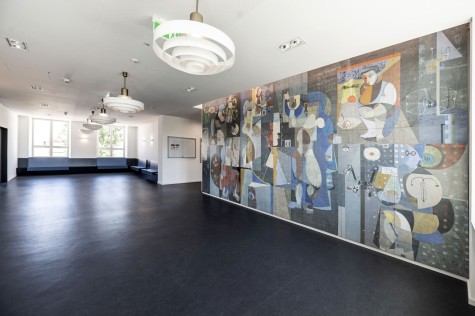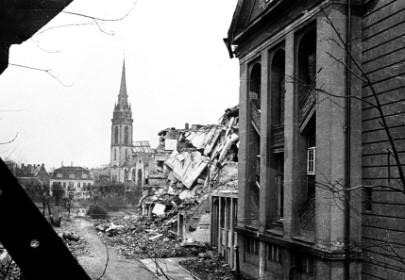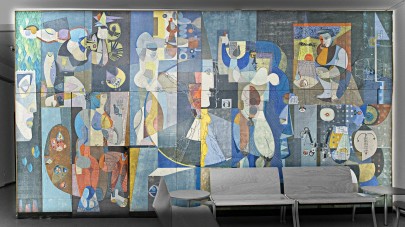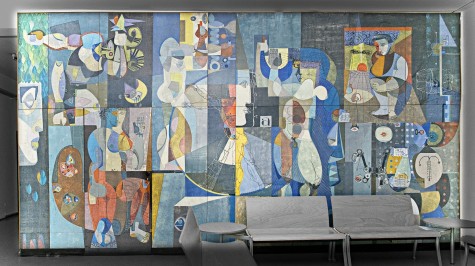Bernd Krimmel's picture cycle “Urgrund aller Dinge” (1956/57)
by Franco Laeri
The Artist Bernd Krimmel
| 1926 | born in Darmstadt |
| 1944 – 1945 | Study of architecture at the Technical University Darmstadt |
| 1945 | Self-employed as a painter and draftsman; quick-draw artist at the “American Red Cross Club” |
| 1955 – 1960 | Executive Chairman of the “Neue Darmstädter Sezession” |
| 1965 | Appointment as Cultural Officer of the City of Darmstadt |
| 1968 – 1971 | Guest lecturer for painting at the Staatliche Hochschule für Gestaltung Mainz |
| 1972 | Director of the Darmstadt City Museum |
| 1975 | Director of the newly founded Mathildenhöhe Institute and the Municipal Art Collections; Cultural Officer |
| ab 1980 | Conception of a museum of the Darmstadt artists' colony in the Ernst-Ludwig-Haus |
| 1989 | Early retirement from public service at own request |
| 2020 | died in Darmstadt |
See also the Wikipedia entry at de.wikipedia.org/wiki/Bernd_Krimmel.
Bernd Krimmel's way of working
Bernd Krimmel (1926–2020) was an artist and exhibition organizer [1]. He has worked and experimented with a wide variety of materials throughout his career.
Although invented as early as the 1930s, ResopalTM, a decorative high pressure laminate, came into vogue in a big way in the 1950s. The material shaped the product aesthetics of the time – the kidney tables are legendary. Resopal was (and still is) manufactured in Groß-Umstadt, not far from Darmstadt. Krimmel looked closely at the possibilities of Resopal for artistic image design. A Resopal picture is created by superimposing layers of colored or painted tissue paper, which together build up the picture and are then impregnated with synthetic resin. To fix it, the whole is pressed into sheets under high pressure and temperature. The delicate tissue paper image is given great mechanical strength and high light resistance by being embedded in the duroplastic material. Especially for artworks in the public space, these properties are very advantageous. Krimmel realized several larger percent for art objects (Kunst am Bau) in and around Darmstadt using this technique [2].
The relationship of the picture cycle to the exhibition site
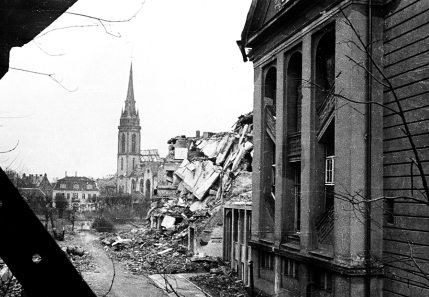
The picture cycle forms a wall in the building S2|04 of the Technical University of Darmstadt, Hochschulstr. 8, separating the foyer on the second floor from the scientists' offices. The building, designed by Darmstadt architecture professor Karl Gruber, was opened in 1942 as a “four-year plan institute” for technical physics of plastics.
It was severely damaged in the major air raid on September 11, 1944. The building was rebuilt after the war and then housed the Institute of Technical Physics, which was headed by Karl-Heinz Hellwege from 1952. Hellwege was also head of the neighboring “German Plastics Institute” from 1955, which was founded in 1951.
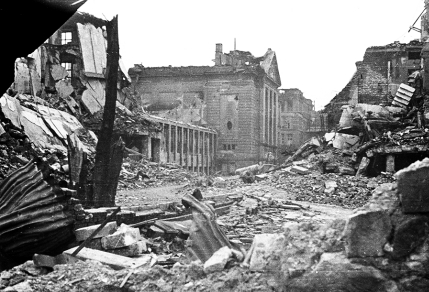
So it is probably no coincidence that he commissioned Bernd Krimmel, who had just caused a sensation with the application of the plastic-based Resopal technique for the design of images in the public domain, to design this wall in the format 631 cm x 332 cm.
Krimmel created a many-faced work full of allusions, symbols and exciting color chords. He describes the picture cycle in the following way:
A head depicted in profile at the left edge of the picture looks at the panorama of human history. In it he recognizes himself and the world: the picture cycle begins at the top left: Homo sapiens invokes and controls fire. Fearing the force of nature, he hides his face behind an apotropaic ram mask. On the right edge of the picture, a child watches as an apple hanging on a string circles the meridians of the globe.
This metaphor of Newton's theory of gravity brings a pinnacle of scientific knowledge into play compositionally. Diagonally opposite, an intimately united human couple conquers the world, procreating. The act of love recalls the biblical legend of Adam and Eve. Richly scattered fruits are the harvest from the tree of knowledge. Leonardo's famous drawing “Man of Vitruvius” appears in the center of the pictorial stories, inscribed in a circle and square. His physicality appears identical with the basic dimensions of the universe. In his studies of proportions, Albrecht Dürer searches for the ratios of Fibonacci numbers and the measures of beauty. The figures of a painter and a sculptor represent the knowledge of the world through the works of art. Orpheus and Eurydice represent music and the intertwining of love and death. At the end of the picture cycle, one sees a nuclear scientist handling the firepower of atoms. However, like the Stone Age man, he must protect himself from their elemental force. He can understand them without “grasping” them in the literal sense. So he has to hide his frail body in armor. The dangerousness of his actions emerges behind the boy who ponders Newton's laws. There, an atomic apocalypse glows bright red.
The colors in this cycle of paintings are created by colored translucent pieces of tissue paper collaged on top of each other according to the intended hue. The entire 631 cm x 332 cm ensemble was solidified at the end by a synthetic resin and thus protected. The overall effect of the complex composition is simply overwhelming.
Acknowledgements: The author thanks Elisabeth and Bernd Krimmel for manifold comments and critical review of the manuscript.
Literature
| [1] |
Krimmel, Bernd [Hrsg.] Katalog zur Ausstellung Symmetrie in Kunst, Natur und Wissenschaft – Mathildenhöhe Darmstadt 1.Juni bis 24 August 1986, Band 2 : Kunst, Darmstadt 1986 |
| [2] |
Georg-August-Zinn-Schule Mainz-Gustavsburg, in Bauen + Wohnen = Construction + habitation = Building + home: internationale Zeitschrift, 10(11) 1956, Seite 378-381 |



